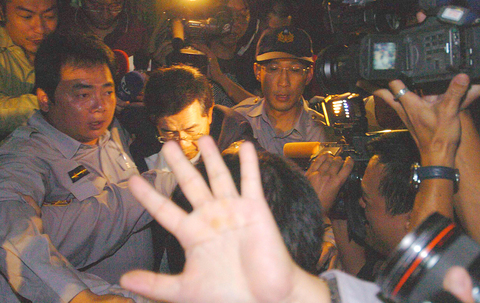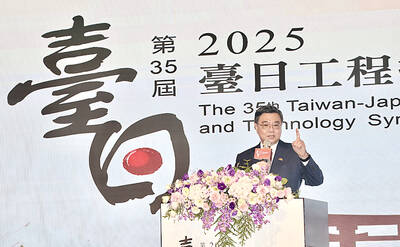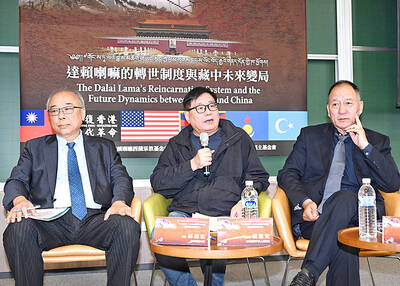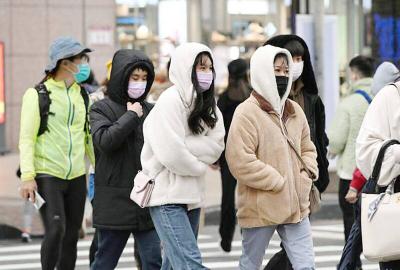Unexpectedly, a scandal that started with a Thai workers riot is now reshaping Taiwan politics.
Not only opposition parties, but also factions inside the Democratic Progressive Party (DPP) and even the local media are attempting to complicate the scandal surrounding the Kaohsiung Rapid Transit Corp (KRTC) in order to take advantage from the situation.
They are expanding the scope of the scandal because they believe that President Chen Shui-bian (

FILE PHOTO: CHANG CHUNG-YI, TAIPEI TIMES
On the other hand, former Kaoshiung city mayor and incumbent Premier Frank Hsieh (謝長廷) has been another target for both opposition and ruling party members. Hsieh, a possible strong contender in the 2008 presidential election, is the planner and builder of the Kaoshiung MRT.
The Kaoshiung City Government began planning to build the MRT in the early 1990s, but the proposal was delayed by former mayor Wu Den-yih (吳敦義), a member of the Chinese Nationalist Party (KMT). Local politicians believed that Wu was unwilling to build the MRT during his term because he was unable to deal with politicians and businessmen who had already cast their covetous eyes on the more than NT$100 billion construction project.
In 1998 Hsieh beat Wu in the mayoral election. Analysts believed that the people of Kaoshiung dumped Wu because the conservative mayor never "contributed to construction in the city." In May 2000, the more aggressive Hsieh announced that the KRTC, which was established in 1999 to bid for the MRT project, beat the Kang Tou Rapid Transit Corp (港都捷運公司) in the race for winning the project bid. The KRTC began construction of the MRT in October 2001.
However, almost four years later, an unexpected riot by Thai workers uncovered the extent of corruption in the KRTC.
On Aug. 21, some 300 of 1,700 Thai workers building the Kaoh-siung MRT rioted over their poor treatment at the hands of Huapan Co, which was appointed by the KRTC to hire and supervise the Thai workers.
After the workers' accusations, it was discovered that the Huapan Co illegally demanded brokerage fees from Thai workers when they applied for work in Taiwan. More seriously, the KRTC was found to be paying each Thai worker NT$29,500 a month, but the workers actually received only about NT$20,000, so more than NT$9,000 of their monthly salary was ending up in somebody else's pockets.
On Aug. 23, Chen Chu (
"The powerful men" have since hogged the headlines in Taiwanese newspapers. Meanwhile, it was alleged that Chen Che-nan and then vice chairman of the KRTC Chen Min-hsien (
"I never went to Thailand and I had nothing to do with the KRTC," Chen Che-nan said more than once.
However, as the scandal continued to expand, on Sept. 5, both Chen Chu and acting Kaohsiung mayor Chen Chi-mai (
On Sept. 6 Kaohsiung judges ordered the detention of Huapan Co's general manager and his wife. A week later, it was found that Chen Min-hsien had illegal brokerage fees flowing into his bank account, he was arrested and released on NT$1.5 million bail.
The scandal further deepened when suspicions were raised about the KRTC's conduct in six public bids for major MRT constructions. Kaohsiung City councilors revealed that although RSEA Engineering Co offered a bid which was NT$2.7 billion lower than that of Hwang Chang Building Co (HCBC), HCBC won the NT$8 billion contract.
To appease public anger and clarify the matter, president Chen asked the new acting Kaohsiung mayor Yeh Chu-lan (葉菊蘭) to form a task force to probe the scandal. After an intensive probe of two weeks, Yeh released the "Kaoh-siung MRT Investigation Report" on Oct. 21.
The report said there was no evidence of "misconduct" by former mayors Hsieh and Wu. But it did not address whether they should be held accountable for their part in adopting a build-operate-transfer (BOT) model that many considered to have been flawed.
The report said, however, that Chen Ming-hsien abused his power to help Tieng Cheng Co win 11 contracts out of 14 public construction bids, with his corrupt practices caused the KRTC to overspend by NT$1.4 billion on the MRT project.
However, the report failed to clear all suspicions. On Oct. 26, when a picture was released by a TVBS talk show showing Chen Che-nan and Chen Min-hsien sitting at a casino table on South Korea's Cheju Island on Nov. 2, 2002, Kaohsiung prosecutors summoned Chen Che-nan for questioning the next day, charged him with corruption and released him on NT$500,000 bail.
Prosecutors proved that Chen Che-nan was entertained by Huapan Co on three foreign trips to Thailand and South Korea.
As the scandal worsened, President Chen on Oct. 30 offered an apology over the KRTC incident.
"I feel sorry and ashamed about Chen Che-nan's integrity problem," the president said.
Chen Chu was summoned for questioning on Oct. 31 by Kaoh-siung prosecutors to learn why the council changed its policy on foreign laborers and whether it was related to alleged intervention by certain prominent figures.
Prosecutors said that the council in May 2001 announced that the county would freeze the introduction of foreign laborers on major infrastructure projects. But in June 2003, the council changed its policy and decided to allow the introduction of foreign workers by the companies in charge of major BOT construction projects.
Prosecutors said that the KRTC in September 2003 had asked the council for permission to use foreign workers, and the council approved KRTC's application at the end of that year.
Kaoshiung prosecutors said they have divided the complicated KRTC scandal into 11 cases because of its gravity. A situation of this magnitude has never occur-red in Taiwanese judicial history, they said.

ALIGNED THINKING: Taiwan and Japan have a mutual interest in trade, culture and engineering, and can work together for stability, Cho Jung-tai said Taiwan and Japan are two like-minded countries willing to work together to form a “safety barrier” in the Indo-Pacific region, Premier Cho Jung-tai (卓榮泰) yesterday said at the opening ceremony of the 35th Taiwan-Japan Modern Engineering and Technology Symposium in Taipei. Taiwan and Japan are close geographically and closer emotionally, he added. Citing the overflowing of a barrier lake in the Mataian River (馬太鞍溪) in September, Cho said the submersible water level sensors given by Japan during the disaster helped Taiwan monitor the lake’s water levels more accurately. Japan also provided a lot of vaccines early in the outbreak of the COVID-19 pandemic,

Kaohsiung Mayor Chen Chi-mai (陳其邁) on Monday announced light shows and themed traffic lights to welcome fans of South Korean pop group Twice to the port city. The group is to play Kaohsiung on Saturday as part of its “This Is For” world tour. It would be the group’s first performance in Taiwan since its debut 10 years ago. The all-female group consists of five South Koreans, three Japanese and Tainan’s Chou Tzu-yu (周子瑜), the first Taiwan-born and raised member of a South Korean girl group. To promote the group’s arrival, the city has been holding a series of events, including a pop-up

TEMPORAL/SPIRITUAL: Beijing’s claim that the next Buddhist leader must come from China is a heavy-handed political maneuver that will fall flat-faced, experts said China’s requirement that the Dalai Lama’s reincarnation to be born in China and approved by Beijing has drawn criticism, with experts at a forum in Taipei yesterday saying that if Beijing were to put forth its own Dalai Lama, the person would not be recognized by the Tibetan Buddhist community. The experts made a remarks at the two-day forum hosted by the Tibet Religious Foundation of His Holiness the Dalai Lama titled: “The Snow Land Forum: Finding Common Ground on Tibet.” China says it has the right to determine the Dalai Lama’s reincarnation, as it claims sovereignty over Tibet since ancient times,

Temperatures in some parts of Taiwan are expected to fall sharply to lows of 15°C later this week as seasonal northeasterly winds strengthen, the Central Weather Administration (CWA) said today. It is to be the strongest cold wave to affect northern Taiwan this autumn, while Chiayi County in the southwest and some parts of central Taiwan are likely to also see lower temperatures due to radiational cooling, which occurs under conditions of clear skies, light winds and dry weather, the CWA said. Across Taiwan, temperatures are to fall gradually this week, dropping to 15°C to 16°C in the early hours of Wednesday